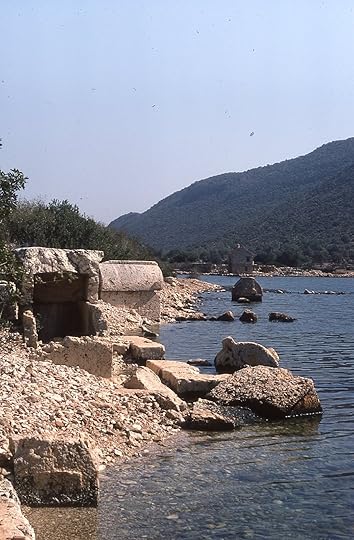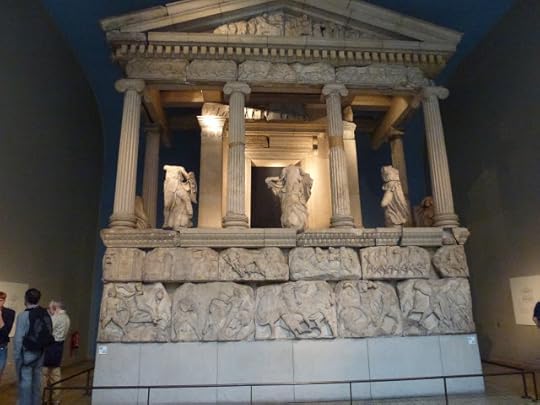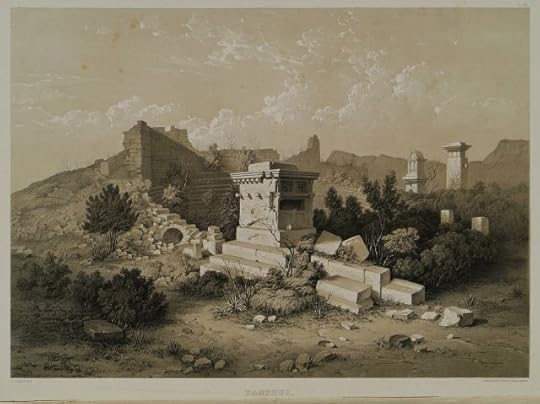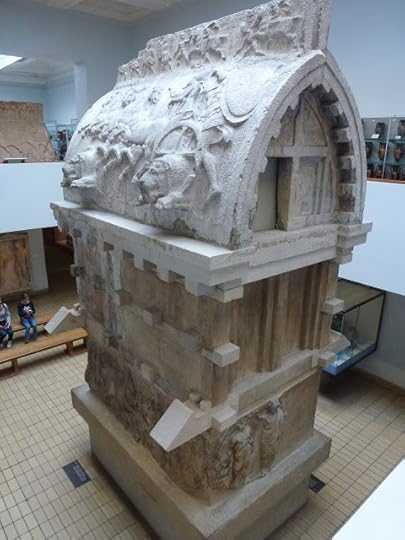Lykia
I made a special trip to the British Museum recently to look at the Lykian monuments from ancient Xanthos. Lykia (or Lycia) was a civilization on the coasts and upland heights of south western Turkey, influenced by both the Persians and the Greeks that reached its height in the sixth and fifth centuries BC. Lykian tombs still dot the landscape, large blocks like immense loaves, and Xanthos itself is hugely impressive.
 Lykian tombs collapse into the sea at Aperlae - a very old slide!
Lykian tombs collapse into the sea at Aperlae - a very old slide!
Conquered by Alexander the Great, the civilization and cities of Lykia were unknown in the West – and were only rediscovered in the 1830s by the British archaeologist and traveller Charles Fellows. Fellows made several expeditions to this remote area, mapped the sites quite carefully and with the permission of the Ottoman authorities and the help of the sailors of a Royal Navy ship, he excavated and removed some of the friezes and remarkable temple-like tombs, which now remain some of the BM’s most impressive exhibits. They include expressive friezes of horses, men, bulls and winged harpies, a complete colonnaded temple – the Nereid monument – immensely popular with visitors for photo opportunities, and some of the tombs with their massive curved stone lids.


 The Nereid monument
The Nereid monument
It was not only the exhibits that fascinated me. It was also Fellows’ written accounts, which I had been reading, of his journeys across western Turkey, accompanied by a dragoman – an interpreter – and an artist called George Scharf, who not only drew pictures of the tombs in situ, but produced vivid vignettes of rural Turkish life, its people, costumes and buildings. I made some of the same journeys on foot in the 1970s and spent time on the Lykian Coast. What struck me about Scharf’s pictures was that, apart from the dress and the disappearance of the fez, much that they saw in the 1840s was still in place in the 1970s, though by then it was on the point of vanishing
I was just getting stuck into a good look at Fellows’ collection at the BM when the fire alarm went off and we all had to shuffle out.
 Scharf's drawing of the tower tombs at Xanthos.
Scharf's drawing of the tower tombs at Xanthos.
 And one in the the BM - the protruding stone 'joists' suggest that these tombs imitated timber structures
And one in the the BM - the protruding stone 'joists' suggest that these tombs imitated timber structures

 Tombs catching the last light of day near Kekova
Tombs catching the last light of day near Kekova
 Lykian tombs collapse into the sea at Aperlae - a very old slide!
Lykian tombs collapse into the sea at Aperlae - a very old slide!Conquered by Alexander the Great, the civilization and cities of Lykia were unknown in the West – and were only rediscovered in the 1830s by the British archaeologist and traveller Charles Fellows. Fellows made several expeditions to this remote area, mapped the sites quite carefully and with the permission of the Ottoman authorities and the help of the sailors of a Royal Navy ship, he excavated and removed some of the friezes and remarkable temple-like tombs, which now remain some of the BM’s most impressive exhibits. They include expressive friezes of horses, men, bulls and winged harpies, a complete colonnaded temple – the Nereid monument – immensely popular with visitors for photo opportunities, and some of the tombs with their massive curved stone lids.



 The Nereid monument
The Nereid monument
It was not only the exhibits that fascinated me. It was also Fellows’ written accounts, which I had been reading, of his journeys across western Turkey, accompanied by a dragoman – an interpreter – and an artist called George Scharf, who not only drew pictures of the tombs in situ, but produced vivid vignettes of rural Turkish life, its people, costumes and buildings. I made some of the same journeys on foot in the 1970s and spent time on the Lykian Coast. What struck me about Scharf’s pictures was that, apart from the dress and the disappearance of the fez, much that they saw in the 1840s was still in place in the 1970s, though by then it was on the point of vanishing
I was just getting stuck into a good look at Fellows’ collection at the BM when the fire alarm went off and we all had to shuffle out.
 Scharf's drawing of the tower tombs at Xanthos.
Scharf's drawing of the tower tombs at Xanthos.
 And one in the the BM - the protruding stone 'joists' suggest that these tombs imitated timber structures
And one in the the BM - the protruding stone 'joists' suggest that these tombs imitated timber structures

 Tombs catching the last light of day near Kekova
Tombs catching the last light of day near Kekova
Published on December 21, 2015 22:11
No comments have been added yet.
Roger Crowley's Blog
- Roger Crowley's profile
- 820 followers
Roger Crowley isn't a Goodreads Author
(yet),
but they
do have a blog,
so here are some recent posts imported from
their feed.



